Of the 30 million practicing Sikhs worldwide, majority are residents of the state of Punjab in India. Sikhs are monotheists who believe in giving and receiving love to create a prosperous and peaceful life. Sikhs are also one of the most powerful warriors among Indian communities but are lover of peace as preached by their revered Gurus. Marriage and family are considered to be one of the primary duties of a Sikh. Through the holy union of marriage one is brought closer to the Divine Love. The Sikh marriage ceremony is known as ‘Anand Karaj’, which has been recognized by Indian Government since 1909. Sikhism is strictly against the practice of dowry at the time of marriage, and grants equal rights to men and women during the process of the wedding. A celebration of union, a Sikh Wedding spans through several days of pre and post wedding ceremonies. The rich culture and strict adherence to religious codes of conduct make the Sikh wedding a study in contrasts. Let’s take a peek at the fascinating rituals of a Typical Sikh Wedding.

Image Source : Wikimedia.org
Pre-wedding Rituals
Roka and Thaka – Parental consent is considered to be of utmost importance when it comes to a Sikh wedding. Be it a love match or an arranged one, the parents of both the bride and the groom must express their consent for the union before the wedding proceedings can progress further. Roka and Thaka, two of the most important pre-wedding rituals, is flip side of the same coin that celebrates the involvement of parents and their wholehearted support. The father of the bride visits the groom’s place and expresses his approval and appreciation by applying a tilak on the groom’s forehead and presenting him with gifts of sweets, clothes etc. The same ritual is practiced by the groom’s parents for the bride. The Roka/Thaka may take place either on the day or a few days prior to the engagement ceremony.
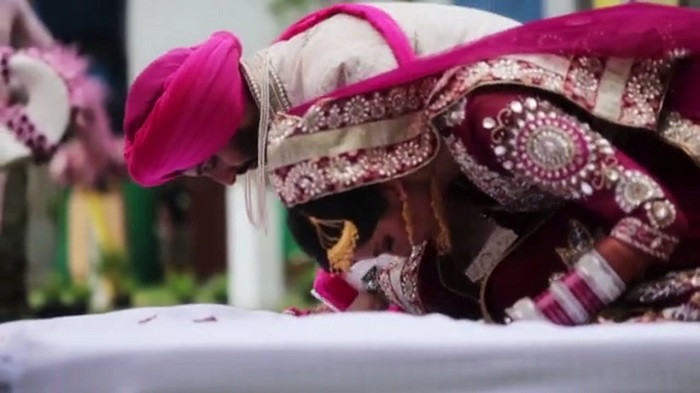
Image Source: Vimeo
Kurmai – Kurmai refers to the formal engagement ceremony that takes place at the groom’s house or at the gurudwara. Close friends and family from both sides attend this event. Before the engagement formalities begin, the priest or Granthi offers a short prayer. Generally, the groom presents a ring to the bride who accepts the same. The bride’s family presents the groom with a Kara, the mandatory steel bangle that Sikh men need to wear and a Kripan, a small knife that is a reminder of the Sikh’s heroic heritage. A red scarf is placed on the groom’s shoulders, around his neck and a few dried dates are placed on the groom’s hands. As per the instructions of the Granthi, the grandfather of the bride feeds the dates to the groom. After these formalities are over, all the guests are served with food and drink.
Akhand Paath – Generally, the weekend before the date of the Anand Karaj is fixed, readers from the family sit down at the house or at the gurudwara to read the entire Guru Granth Sahib within 48 hours’ time. The non-readers assist the reader by providing them with nourishment. Both the bride and the groom’s family hold this ritual separately. This event aims to explain to the bride and groom the importance of religion and the teachings from Guru Granth Sahib outlining the pious way of living.
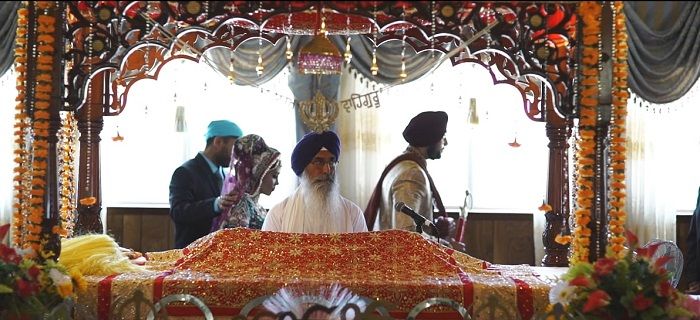
Image Source: Vimeo
Kirtan – Kirtan is a performance of religious music. Prior to Anand Karaj, the Sikhs consider it good omen to hold at least one Kirtan performance at their residence. Experienced musicians, known as Raagis, associated with the local gurudwara sing ‘Gurbani’ accompanied by tabla and harmoniums.
Ardas – On the days leading up to the Anand Karaj, the family members visit the gurudwara daily to offer prayers. They cover their heads and wash their hands and feet before entering the prayer hall. Next, they open the Guru Granth Sahib at a random page and start reading and reciting the prayers out loud.
Karah Prasad and Langar – A sweet Prasad is made by the family members at the gurudwara with semolina, flour, ghee and nuts. After completion of the prayers, the Prasad is distributed among the attendees. The attendees also devour on community style meal at the gurudwara known as Langar.
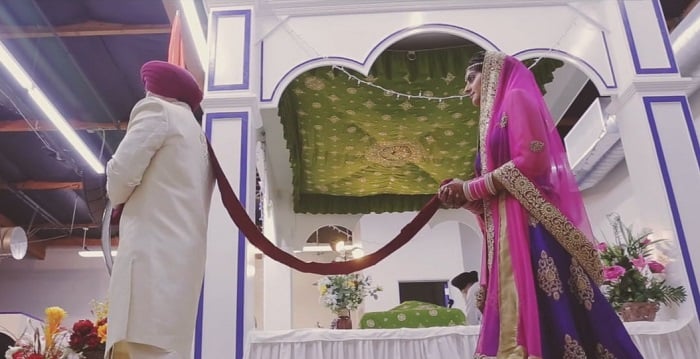
Shagan – The bride’s family sends the groom’s family gifts prior to the wedding. These gifts are presented in beautifully decorated trays and are carried by the bride’s relatives to the groom’s house. Generally, sweets, fruits, dry fruits, clothes and a coconut are included in the Shagan.
Chunni Chadana – A few days before the Anand Karaj, the groom’s female relatives visit the bride’s place bringing her an outfit she is supposed to wear on her wedding day, including jewelry, accessories, makeup kits etc. The mother of the groom covers the bride’s head with a sanctified headscarf or chunni. This signifies that she has accepted the bride to be a part of her family.
Maiya – This refers to a cleansing ceremony. The bride/groom is made to sit down on a stool and oil is applied to their hair while turmeric paste is applied on their body. A red cloth is held over their heads with female relatives holding up each corner. Remaining female guests sing traditional wedding songs. The ceremony takes place on any of the preceding five days from the wedding.
Karahi Chadana – Five days before the wedding, the karahi chadana ritual is observed by Sikh families. A large Karahi or Wok is set up at the kitchen and all the food items – savory or sweet is cooked in that. Guests are served from the same vessel during these five days.
Warna – The Warna ritual is performed on the bride and the groom by various family members on days before the wedding. Any amount of currency notes are waved around the bride’s/groom’s head clockwise and the money is then given away to charity. This is done to cast away any evil energy surrounding the would-be couple.
Gaana – The next ritual is Gana, wherein a red thread is tied on the right wrist of the groom and on the left wrist of the bride. This is considered to protect them from ill omen.
Gharoli – The bride or the groom’s sister-in-law visits a nearby gurudwara and fills up a special earthenware pot called Gharoli with holy water. She brings the water filled pot back to the house which is then used to bathe the bride/groom after their Vatnaa.
Vatnaa – A paste is made of turmeric, barley and mustard by the women of the house. The bride/groom is made to sit on a low stool and the married women of the family anoint them with the specially prepared paste. Wedding songs are sung for the occasion and there is a general sense of merriment.
Mehendi – The mehendi ceremony is practiced two or three days before the wedding. Henna paste is applied to the bride’s hands and feet in elaborately beautiful patterns. The women of the family gather for this occasion and have henna designs applied to their hands as well. There is copious amount of fun and festivities, with singing of traditional wedding songs.
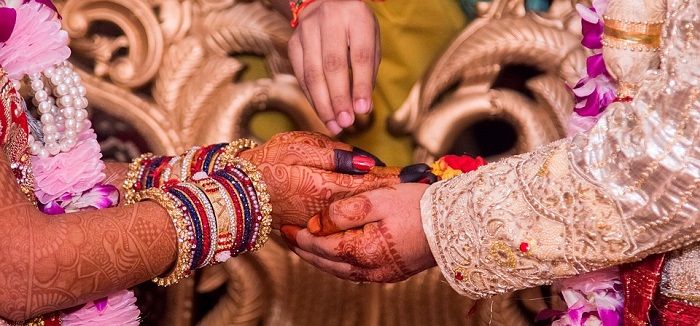
Chooda and Kalire – The maternal uncle of the bride gifts her Chooda, a set of 21 red and white bangles. Prior to the ceremony, these bangles have to be sanctified by washing them with curd and rosewater. Once the bride has worn the bangles, they are covered with a silk shawl so that she cannot see them.
After the chooda ceremony, the relatives of the bride come up to her and tie umbrella-shaped metallic ornaments called Kalire to her bangles and offer their blessings. All the unmarried friends and relatives of the bride are lined up and she moves the Kalire over each girl’s head. It is believed that on whosever head a Kalire falls, she will be the next one to get married.
Wedding Attire
Traditional Sikh grooms prefer wearing Kurta, generally white in color, over which they don an Achkan or long overcoat. The achkan is often made of premium fabrics like silk or brocade. Nowadays grooms also wear Sherwanis over the kurta instead of a traditional achkan. The Achkan or the Sherwani are highly embellished with threadwork, beadwork and even with precious stone setting sometimes. He pairs either the Achkan or the Sherwani with a Churidar Pajama. The groom also sports a traditional ‘Mojri’ as part of his wedding outfit which is an embellished slipper. The groom is required to sport a beard as a symbol of adherence to the Sikh faith and he is supposed to wear a turban around his head, typically of pink cloth.
A typical Sikh bride prefers to wear a highly ornate, beautifully embroidered set of Salwar Kameez. Red is a much preferred color, although most shades in that color family are considered appropriate. She has to cover her head with the Salwar-Kameez’s dupatta. Nowadays, Lehengas are also preferred as wedding dresses by Sikh brides. She wears a lot of traditional jewelry as well, starting from necklaces, earrings, bangles, to mangtika, panja and payal.
Wedding Rituals
Sehra Bandi – On the day of the wedding, before the wedding party departs from the groom’s home, the turban is tied around the groom’s head by his father. He is handed over a fake sword by his father that he has to carry during all the wedding ceremonies. The sister of the groom then ties the Sehra, a curtain made of golden ribbons or flowers or even string of pearls, around the turban and covering the groom’s face.
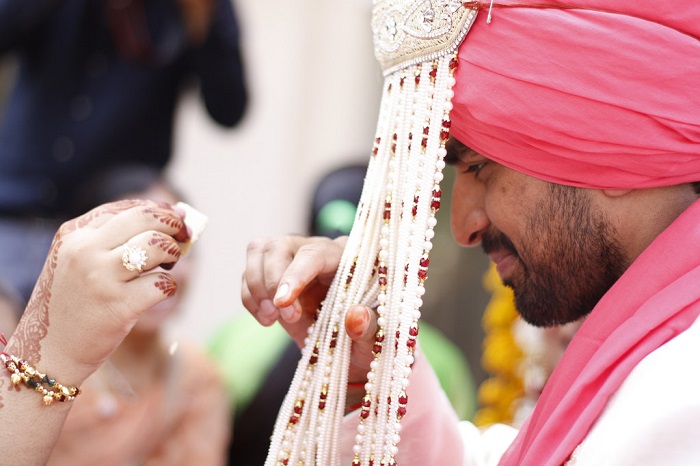
Soorma and Kalgi – The groom’s sister-in-law applies a black dot of kohl or surma on the side of his forehead to ward off any negative energy from the groom. The sister of the groom then ties a piece of jewelry on his turban and stands between him and the door. She demands gifts in exchange for letting him go to the wedding. The groom has to present her with a gift before he can leave for the wedding venue.
Baraat – Traditionally speaking, the groom is supposed to travel to the bride’s place on a mare. Nowadays, the groom takes a car for the most part of the journey and before entering the wedding venue mounts the mare, which is decorated with golden ribbons and other trimmings. Relatives and friends of the groom accompany him to the wedding venue. Music and Bhangra dance is an integral part of a Baraat. Generally, a band is hired to provide the music to which the Baraatis dance.
Milni – The baraat is welcomed at the gate of the wedding venue, which is traditionally the Gurudwara, by the bride’s side. They are welcomed in by the bride’s side who sing hymns and utter their faith in God’s workings. Mostly men participate in the Milni event mediated by a priest. As each member of the baraat is introduced, the bride’s side offers them a garland and a warm hug.
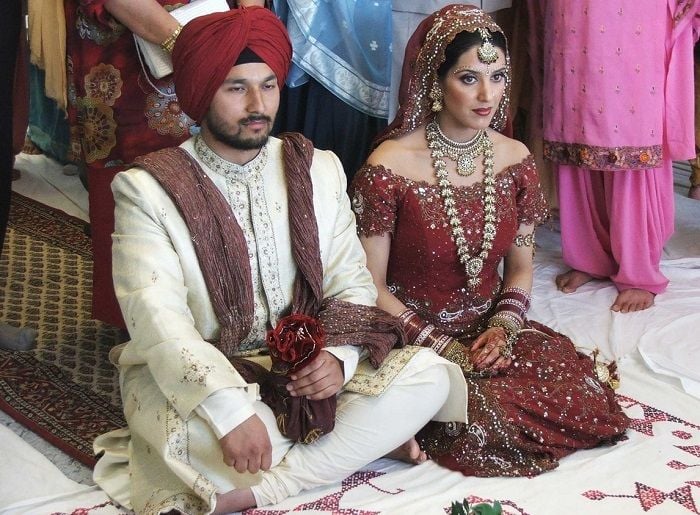
Anand Karaj – Anand Karaj literally means ‘Blissful Union’. The ceremony takes place at the Gurudwara prayer hall during the daytime or during afternoons. The Guru Granth Sahib is placed at a site of prominence and the marriage ceremony is designed around it. The bride and the groom sit side-by-side - bride on the left side of the groom, facing the Guru Granth Sahib. The ceremony starts with the couple and their parents standing up to offer Ardaas to ‘Waheguru’, after which singing of Shabads or hymns is done. The marriage can be performed by any Amritdhari Sikh that is someone who had undergone the Amrit Initiation in Sikhism. He explains to the couple the significance of the marriage, the duties that each need to perform within the sacred relationship, and the general idea of leading a pious life according to Sikh tenets. The couple then bows down before the Guru Granth Sahib. The father of the bride places a saffron colored scarf on the groom’s shoulder and the other end of the same on his daughter’s hand. Thus, they are joined and ready to take the Lavaas or vows of marriage.
Lavaan Pheras – The person conducting the marriage recites the four Lavaa or stanzas from the Guru Granth Sahib. After he has completed reading the first stanza, the couple rises from their seats and slowly walks around the Guru Granth Sahib in clockwise direction, with the groom leading the bride. After completion of the round they come back to their positions but remain standing for the remaining three hymns. The process of circumambulation is repeated three more times after each Lavaa. The raagis sing the Lavaas in the background while the couple performs the Pheras.
Anand Sahib – After completion of the Lavan Pheras, the raagis sing out the hymns of Anand Sahib. An Ardaas is offered as an indication that the wedding ceremony is now complete. A random Hymn from the Guru Granth Sahib is chosen to be recited while Khatah Prasad is distributed among all the attendees.
Wedding Lunch – At the end of the wedding ceremony, the guests and the attendees are served delicious vegetarian lunch at the Gurudwara’s congregational hall. Thereafter, a ceremony called Roti takes place, which signifies the bride’s first meal as a married woman. Her in-laws cover the platter with a cloth and present it to the bride along with some cash gift. The bride shares this meal with the groom.
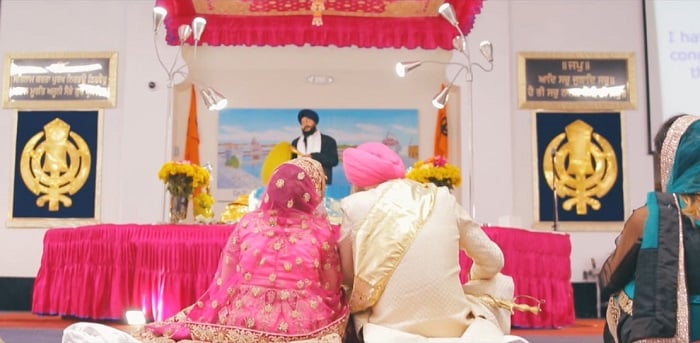
Post-wedding Rituals
Sadaa Suhagan – The bride changes her wedding outfit and gets dressed in the outfit and jewelry gifted to her by the groom’s side. Elders of the family bless the bride with cash gifts and wishes of Sada Suhagan, meaning may the bride be lucky to never experience widowhood.
Doli and Vidaai – The bride prepares to leave her parent’s house. Doli refers to a wooden palanquin that was used to carry around women in olden days. Today, it is symbolic of the bride’s departure from her paternal home. The bride throws rice grains over her shoulders and into her mother’s outstretched hands, thus wishing her parent’s eternal prosperity. She gets into a beautifully decorated car with her husband and drives away towards her new home.
Welcoming the new Bride – The bride generally receives a warm welcome when she reaches the groom’s home. She is showered with flowers and fed sweets. Relatives and neighbors come over to meet the new bride and offer her blessings.
Reception – A grand reception party is hosted by the groom’s side to honor the newly-wed couple. Family and friends are invited to enjoy a lavish meal along with ample opportunity to have fun singing and dancing.




